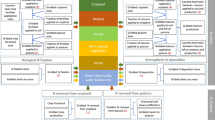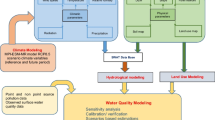Abstract
Agricultural management practices are among the major drivers of agricultural nitrogen (N) loss. Legislation and management incentives for measures to mitigate N loss should eventually be carried out at the individual farm level. Consequently, an appropriate scale to simulate N loss from a scientific perspective should be at the farm scale. A data set of more than 4000 agricultural fields with combinations of climate, soils and agricultural management which overall describes the variations found in the Baltic Sea drainage basin was constructed. The soil–vegetation–atmosphere model Daisy (Hansen et al. 2012) was used to simulate N loss from the root zone of all agricultural fields in the data set. From the data set of Daisy simulations, we identified the most important drivers for N loss by multiple regression statistics and developed a statistical N loss model. By applying this model to a basin-wide data set on climate, soils and agricultural management at a 10 × 10 km scale, we were able to calculate root-zone N losses from the entire Baltic Sea drainage basin and identify N loss hot spots in a consistent way and at a level of detail not hitherto seen for this area. Further, the root-zone N loss model was coupled to estimates of nitrogen retention in catchments separated into retention in groundwater and retention in surface waters allowing calculation of the coastal N loading.









Similar content being viewed by others
References
Andersen, H. E., Kronvang, B., & Larsen, S. E. (1999). Agricultural practices and diffuse nitrogen pollution in Denmark: empirical leaching and catchment models. Water Science and Technology, 39(12), 257–264.
Arheimer, B., & Brandt, M. (1998). Modelling nitrogen transport and retention in the catchments of southern Sweden. Ambio, 27(6), 471–480.
Benoist, G. and Marquer, P. (2006a). Farm structure in Denmark – 2005. Statistic in focus – Agirculture and Fisheries from Eurostat.8 pages.
Benoist, G. and Marquer, P. (2006b). Farm structure in Sweden – 2005. Statistic in focus – Agirculture and Fisheries from Eurostat.8 pages.
Benoist, G. and Marquer, P. (2006c). Farm structure in Poland – 2005. Statistic in focus – Agirculture and Fisheries from Eurostat.8 pages.
Benoist, G. and Marquer, P. (2006d). Farm structure in Denmark – 2005. Statistic in focus – Agirculture and Fisheries from Eurostat.8 pages.
Benoist, G. and Marquer, P. (2006e). Farm structure in Estonia – 2005. Statistic in focus – Agirculture and Fisheries from Eurostat.8 pages.
Benoist, G. and Marquer, P. (2006f) Farm structure in Lithuania – 2005. Statistic in focus – Agirculture and Fisheries from Eurostat.8 pages.
Benoist, G. and Marquer, P. (2006g). Farm structure in Latvia – 2005. Statistic in focus – Agirculture and Fisheries from Eurostat.8 pages.
Benoist, G. and Marquer, P. (2006h). Farm structure in Finland – 2005. Statistic in focus – Agirculture and Fisheries from Eurostat.8 pages.
Blicher-Mathiesen, G., Andersen, H. E., Carstensen, J., Børgesen, C. D., Hasler, B., & Windolf, J. (2014). Mapping of nitrogen risk areas. Agriculture, Ecosystems and Environment, 195, 149–160.
Britz W., Pérez I., Zimmermann A., Heckelei T. (2007). Definition of the CAPRI Core Modelling System and Interfaces with other Components of SEAMLESS-IF, SEAMLESS Report No.26, SEAMLESS integrated project, EU 6th Framework Programme, contract no. 010036–2, www.SEAMLESS-IP.org/, 116 pp, ISBN no. 90-8585-114-9 and 978-90-8585-114-1.
Büttner, G., Feranec, J. and Jaffrain, G. (2002). Corine land cover update 2000. EEA Technical report 89 ISBN: 92-9167-511-3. pp 56.
Christensen, N. & Jørgensen, F. (1990). Næringsstofomsætning i marginaliseret landbrugsjord. NPo-rapport nr. A13. Miljøstyrelsen, pp 62 (in Danish).
Donnelly, C., Dahné, J., Lindström, G., Rosberg, J., Strömqvist, J., Pers, C., Yang, W., & Arheimer, B. (2009). An evaluation of multi-basin hydrological modelling for predictions in ungauged basins. IAHS Publication, 333, 112–120.
EEA (2007). European Environment Agency. CLC2006 Technical guidelines. EEA report No. 17/2007. Copenhagen, 2007.
EMEP (2012). European Monitoring and Evaluation Programme. http://webdab.emep.int/Unified_Model_Results/.
EU-JRC (2010). EU Joint Research Centre. Global Land Cover 2000. http://bioval.jrc.ec.europa.eu/products/glc2000/products.php.
EU-JRC (2012). EU Joint Research Centre. Monitoring Agricultural Resources Unit (MARS). http://mars.jrc.ec.europa.eu/mars/About-us/AGRI4CAST/Data-distribution.
EUROSTAT (2013). http://epp.eurostat.ec.europa.eu/portal/page/portal/eurostat/home/.
FAO (2003). Fertilizer use by crop in Poland. FAO.ftp://ftp.fao.org/docrep/fao/005/y4620E/y4620E00.pdf
FAOSTAT. 2013. http://faostat3.fao.org/faostat-gateway/go/to/home/
Ferguson, R. I. (1986). River loads underestimated by rating curves. Water Resources Research, 22, 74–76.
Grant, R., Blicher-Mathiesen, Andersen, H.E, Jensen, P.G., Pedersen, M & Rasmussen, P. (2001). Landovervågningsoplande 2001. National Environmental Research Institute. Research report no. 420. p126.
Grant, R., Blicher-Mathiesen, G., Jensen, P.G., Hansen, B. & Thorling, L. (2011). Landovervågningsoplande 2010. NOVANA. Aarhus University, DCE – Danish Center for Energy and Environment. 130 pages. Scientific report from DCE – Danish Center for Energy and Environment no. 3 (in Danish).
Grimvall, A., & Stålnacke, P. (1996). Statistical methods for source apportionment of riverine loads of pollutants. Environmetrics, 7(2), 201–213.
Grizzetti, B., Bouraoui, F. & Aloe, A. (2007). Spatialised nutrient balance for Europe,, EUR Rep. 22692 EN, 98 pp., Univ. Pierre et Marie Curie-Paris 6, Paris.
Gundersen, P., Sevel, L., Christiansen, J. R., Vesterdal, L., Hansen, K., & Bastrup-Birk, A. (2009). Do indicators of nitrogen retention and leaching differ between coniferous and broadleaved forest in Denmark. Forest Ecology and Management, 258, 1137–1146.
Hansen, S., Thirup, C., Refsgaard, J. C., & Jensen, J. S. (2001). Modelling of nitrate leaching at different scales—application of the Daisy. In M. Shaffer, M. Liwang, & S. Hansen (Eds.), Modeling carbon and nitrogen dynamics for soil management (pp. 511–547). Boca Raton: Lewis Publishers.
Hansen, S., Abrahamsen, P., Petersen, C. T., & Styczen, M. (2012). Daisy: model use, calibration and validation. Transactions of the ASABE, 55(4), 1315–1333.
Heidmann, T., Tofteng, C., Abrahamsen, P., Plauborg, F., Hansen, S., Battilani, A., Coutinho, J., Dolezal, F., Mazurczyk, W., Ruiz, J. D. R., Takác, J., & Vacek, J. (2008). Calibration procedure for a potato crop growth model using information from across Europe. Ecological Modelling, 211(1–2), 209–223.
HELCOM (2004). The fourth Baltic Sea pollution load compilation (PLC-4), Baltic Sea Environment Proceedings, Baltic Sea Environment Proceedings, 93, 133 pp., 2004.
HELCOM (2011). The Fifth Baltic Sea Pollution Load Compilation (PLC-5). Balt. Sea Environ. Proc. No. 128.
Høgh-Jensen, H., Loges, R., Jensen, E.S., Jørgenen, F.V. & Vinther, F.P. (2003). Empirical model for quantification of symbiotic nitrogen fixation in leguminous crops. Agricultural Systems http://www.orgprints.org/, 1–31.
Hong, B., Swaney, D.P., Mörth, C.M., Smedberg, E., Hägg, H.E., and Humborg, C. (2011). NANI/NAPI Calculator Toolbox Version 2.0 Documentation: net anthropogenic nutrient inputs in Baltic Sea catchments (March, 2011). Baltic Nest Institute Sweden. 95 pages.
Humborg, C., Danielsson, Å., Sjöberg, B., & Green, M. (2003). Nutrient land-sea fluxes in oligotrophic and pristine estuaries of the Gulf of Bothnia, Baltic Sea. Estuarine, Coastal and Shelf Science, 56, 781–793.
HWSD (2008). Harmonized World Soil Database (HWSD), version 1.1, March 2008, published by FAO, IIASA, ISRIC, ISSCAS, JRC (available online).
Kronvang, B., Andersen, H. E., Børgesen, C. D., Dalgaard, T., Larsen, S. E., Bøgestrand, J., & Blicher-Mathiesen, G. (2008). Effects of policy measures implemented in Denmark on nitrogen pollution of the aquatic environment. Environmental Science & Policy, 144–152.
Larsson, U., Elmgren, R., & Wulff, F. (1985). Eutrophication of the Baltic Sea—causes and consequences. Ambio, 14, 9–14.
Lehmann, E. L., & Casella, G. (1998). Theory of point estimation (2nd ed.). New York: Springer. 589 pages.
Lepistö, A., Granlund, K., Kortelainen, P., & Räike, A. (2006). Nitrogen in river basins: sources, retention in the surface waters and peatlands, and fluxes to estuaries in Finland. Science of the Total Environment, 365, 238–259.
Liden, R., Vasilyev, A., Stålnacke, P., Loigu, E., & Wittgren, H. B. (1999). Nitrogen source apportionment—a comparison between a dynamic and a statistical model. Ecological Modelling, 114(2–3), 235–250.
Mattson, T., Finer, L., Kortelainen, P., & Sallantaus, T. (2003). Brook water quality and background leaching from unmanaged forested catchments in Finland. Water, Air, and Soil Pollution, 147, 275–297.
Mörth, C.-M., Humborg, C., Eriksson, H., Danielson, A., Medina, M. R., Löfgren, S., Swaney, D. P., & Rahm, L. (2007). Modeling riverine nutrient transport to the Baltic Sea: a large-scale approach. Ambio, 36(2–3), 124–133.
Nash, J. E., & Sutcliffe, J. V. (1970). River flow forecasting through conceptual models part I—a discussion of principles. Journal of Hydrology, 10(3), 282–290.
Nielsen, K. E., Ladekarl, U. L., & Nørnberg, P. (1999). Dynamic soil processes on heathland due to changes in vegetation to oak and Sitka spruce. Forest Ecology and Management, 114, 107–116.
Pyykkönen, S., Grönroos, J., Rankinen, K., Laitinen, P., Karhu, E. & Granlund, K. (2004). Ympäristötuen mukaiset viljelytoimenpiteet ja niiden vaikutukset vesistökuormitukseen 2000–2002. Finnish Environment 711, Finnish Environment Institute. Edita Prima Oy, Helsinki.p119.
Rawlings, J. O. (1988). Applied regression analysis. Belmont: Wadsworth and Brooks/Cole.
Salo, T., Lemola, R., & Esala, M. (2007). National and regional net nitrogen balances in Finland in 1990–2005. Agricultural and Food Science, 16, 366–375.
Schilling, C., Behrendt, H., Blaschke, A., Danielescu, S., Dimova, G., Gabriel, O., Heinecke, U., Kovacs, A., Lampert, C., Postolache, C., Schreiber, H., Strauss, P., & Zessner, M. (2005). Lessons learned from investigations on case study level for modelling of nutrient emissions in the Danube Basin. Water Science and Technology, 51(11), 183–191.
Snedecor, G.W., Cochran, W.G. (1989). Statistical Methods. Iowa State University Press, Ames, Iowa. Taylor, R., Florczyk, H., Jakubowska, L., 1989. Run-off of nutrients from river watersheds used for agricultural purposes Environ. Prot. Eng., 1245065.
Stålnacke, P., Pengerud, A., Vassiljev, A., Smedberg, E., Mörth, C.-M., Hägg, H. E., Humborg, C., & Andersen, H. E. (2015). Nitrogen surface water retention in the Baltic Sea drainage basin. Hydrology and Earth System Sciences, 19, 981–996.
Statistics Belarus. (2010). Agriculture of the Republic of Belarus. Statistical Book. 270 pages.
Statistics Belarus. (2013). Yearbook of the Republic of Belarus. 557 pages.
Statistics Denmark. (2001). Livestock density in agriculture 2000. Statistisk Efterretning No.13. p 41.
Statistics Denmark. (2006). Agricultural statistics 2005. 251 pages.
Statistics Estonia. (2001). 2001 Agricultural Census. http://www.stat.ee/agricultural-census-2001.
Statistics Estonia. (2013). http://www.stat.ee/economy.
Statistics Finland. (2004). Yearbook Farm Statistics. Information Centre of the Ministry of Agriculture and Forestry. Helsinki. 2004.
Statistics Latvia. (2013). http://www.csb.gov.lv/en/statistikas-temas/metodologija/agricultural-output-indices-38871.html.
Statistics Lithuania. (2013). http://web.stat.gov.lt/en/pages/view/.
Statistics Sweden. (2002). Use of fertilizer and manure in agriculture in 2000/2001.Report MI 30 SM 2002. (In Swedish, summary in English). 94 p.
Sweitzer, J., Langaas, S., & Folke, C. (1996). Land cover and population density in the Baltic Sea drainage basin: a GIS database. Ambio, 25, 191–198.
van Genuchten, M. T. (1980). A closed form equation for predicting the hydraulic conductivity of unsaturated soils. Soil Science Society of America Journal, 44, 892–898.
Vassiljev, A., & Stålnacke, P. (2005). Source apportionment of nutrients in the Lake Peipsi drainage basin—experiences from a statistical model. Water Science and Technology, 51(3–4), 309–317.
Vassiljev, A., Blinova, I., & Ennet, P. (2008). Source apportionment of nutrients in Estonian rivers. Desalination, 226(1–3), 222–230.
Voss, M., Dippner, J. W., Humborg, C., Hürdler, J., Korth, F., Neumann, T., Schernewski, G., & Venohr, M. (2011). History and scenarios of future development of Baltic Sea eutrophication. Estuarine, Coastal and Shelf Science, 92, 307–322.
Wösten, J. H. M., Pachepsky, Y. A., & Rawl, W. J. (2001). Pedotransfer functions: bridging the gap between available basic soil data and missing soil hydraulic characteristics. Journal of Hydrology, 251, 123–150.
Author information
Authors and Affiliations
Corresponding author
Ethics declarations
Funding
This study is a contribution from the RECOCA project, which has received funding from the BONUS+ programme funded jointly by the European Community’s Seventh Framework Programme (FP7/2007–2013, grant agreement 217246) and Baltic Sea national funding institutions. Additional funding was for the Danish authors provided under the research alliance IMAGE of the Danish Strategic Research Council.
Conflict of Interest
The authors declare that they have no competing interests.
Rights and permissions
About this article
Cite this article
Andersen, H.E., Blicher-Mathiesen, G., Thodsen, H. et al. Identifying Hot Spots of Agricultural Nitrogen Loss Within the Baltic Sea Drainage Basin. Water Air Soil Pollut 227, 38 (2016). https://doi.org/10.1007/s11270-015-2733-7
Received:
Accepted:
Published:
DOI: https://doi.org/10.1007/s11270-015-2733-7




